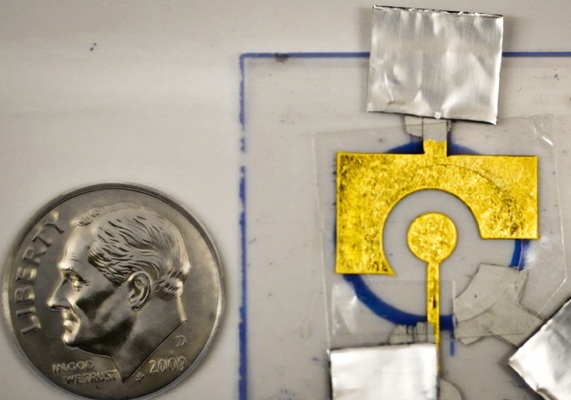Inexpensive DNA Coated Electrode Paves Way for Disposable Diagnostics
Posted on 03 Jul 2025
Many people around the world still lack access to affordable, easy-to-use diagnostics for diseases like cancer, HIV, and influenza. Conventional sensors, while accurate, often rely on expensive equipment or require refrigeration, limiting their use in low-resource or non-clinical settings. One major limitation with DNA-based electrochemical sensors is that the DNA coating breaks down quickly, requiring the sensors to be prepared immediately before use and stored under tightly controlled conditions. This significantly restricts their practicality, especially in rugged or remote environments. Researchers have now developed a new solution that stabilizes these sensors for longer shelf life and better usability, even at high temperatures, without compromising diagnostic accuracy.
Developed by a team at MIT (Cambridge, MA, USA), the new electrochemical sensor uses a gold leaf electrode coated with DNA and stabilized with polyvinyl alcohol (PVA), a low-cost polymer. The sensors are based on CRISPR-associated enzyme Cas12, which is paired with guide RNA to detect specific DNA or RNA targets. When the target—such as a cancerous gene—is present, the enzyme activates and nonspecifically cleaves the DNA coating the electrode, thereby altering the electrical signal. This signal can be measured using a potentiostat, similar to the technology in glucose meters. The PVA coating acts like a protective tarp, preventing oxidative damage and preserving the thiol-gold bond that secures the DNA. Once dried, the PVA forms a barrier that protects the DNA until it’s ready to be rinsed off for use. These sensors, costing only around 50 cents each, can be laminated onto plastic and are intended for point-of-use applications, including at-home testing. Earlier versions were already capable of detecting HIV and HPV; the latest design further enhances usability by increasing shelf-life and simplifying deployment.

In the study published in ACS Sensors, the researchers demonstrated that the PVA coating preserved sensor stability for up to two months, even at temperatures as high as 150°F. After storage, the sensors successfully detected PCA3, a prostate cancer gene found in urine, and the method can be adapted for saliva, nasal swabs, and other sample types. The team now plans to expand testing with real-world patient samples across multiple diseases. With support from MIT’s delta v venture accelerator, the group is exploring commercialization opportunities to ship the stabilized sensors to low-resource regions without requiring refrigeration. They are also working on adapting the platform to respond to emerging infectious diseases and scale distribution for widespread use.
“Our goal is to continue to test with patient samples against different diseases in real-world environments,” said Ariel Furst, the Paul M. Cook Career Development Assistant Professor of Chemical Engineering at MIT and senior author of the study. “Our limitation before was that we had to make the sensors on site, but now that we can protect them, we can ship them. We don’t have to use refrigeration. That allows us to access a lot more rugged or non-ideal environments for testing.”
Related Links:
MIT














